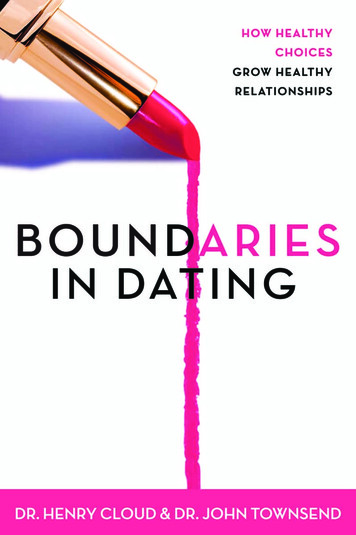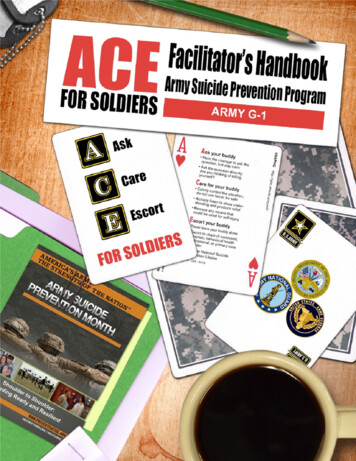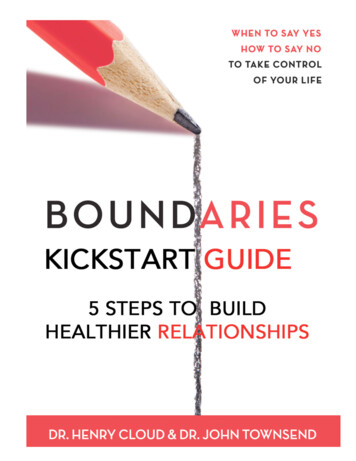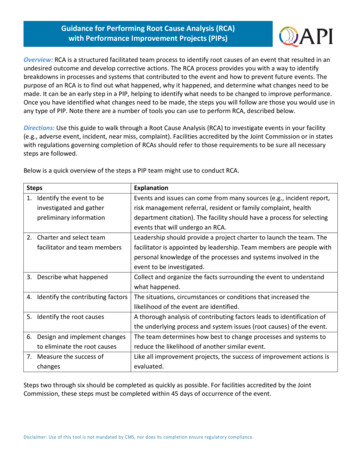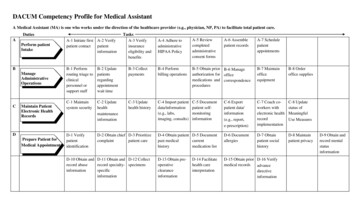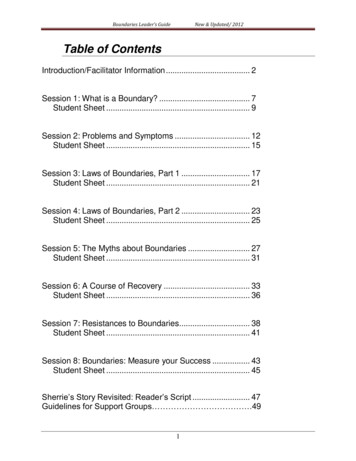
Transcription
Boundaries Leader’s GuideNew & Updated/ 2012Table of ContentsIntroduction/Facilitator Information . 2Session 1: What is a Boundary? . 7Student Sheet . 9Session 2: Problems and Symptoms . 12Student Sheet . 15Session 3: Laws of Boundaries, Part 1 . 17Student Sheet . 21Session 4: Laws of Boundaries, Part 2 . 23Student Sheet . 25Session 5: The Myths about Boundaries . 27Student Sheet . 31Session 6: A Course of Recovery . 33Student Sheet . 36Session 7: Resistances to Boundaries. 38Student Sheet . 41Session 8: Boundaries: Measure your Success . 43Student Sheet . 45Sherrie’s Story Revisited: Reader’s Script . 47Guidelines for Support Groups .491
Boundaries Leader’s GuideNew & Updated/ 2012IntroductionThe Boundaries study takes participants on a unique journey - of spiritual growth,challenge to change, problem solving, recovery, and hope. It offers practical help,encouragement, insight and wisdom to all who struggle with their inability to say no, aswell as to anyone who seeks to live a healthy and balanced life.This DVD study is based on the book Boundaries – When to Say Yes, How to Say No,to Take Control of Your Life by Dr. Henry Cloud and Dr. John Townsend. The courseemphasizes the importance of setting healthy boundaries in order to have healthyrelationships. It will help people already in healthy situations to improve theirrelationships - as well as provide badly-needed guidance to those whose lives are out ofcontrol. Many will discover painful realities about their lives – the family they grew up in,present relationships, addictive behaviors, codependency – and will be challenged toaccept personal responsibility and ownership in order to experience new freedom. Yourgroup will be asked to minister to one another in a spirit of openness and love.How to Use this SeriesThis series is divided into eight (8) sessions. Each session is designed to use DVDcontent (Dr. Cloud and Dr. Townsend) along with small group interaction. You shouldplan at least thirty minutes of discussion for each DVD session. Depending on theamount of time you have, you may decide to spend two periods on some sessions.Due to the interactive nature of the material, a small group (6-8 individuals) is best forprocessing the information. However, if you have a large group interested in this DVDstudy, we suggest watching the DVD together first, and then breaking off into smallgroups for discussion. The small groups should remain the same throughout the entireseries, as trust must be built between members in order to facilitate sharing. Theatmosphere should be one of a warm and caring community of believers gatheredtogether to encourage one another.As with most small groups, a discussion leader for this series does not need to have allthe answers. However, you should be willing to honestly share your own struggles,conscientiously prepare for each group session, consistently pray for the group, and bea person who can guide interaction, offer support, and assist with follow-up. You needto realize you are investing your time in people – trust God to give you His wisdom.If you would like additional information on how to facilitate a small group, we suggestyou use the book, Making Small Groups Work by Dr. Cloud and Dr. Townsend.2
Boundaries Leader’s GuideNew & Updated/ 2012Each Session Contains Main Ideas Numerous Scripture References referred to in the DVD and/or the Book: Thisincludes those instances Dr. Cloud and Dr. Townsend quote the Scripture as partof their text, but do not cite where it is found in the Bible. Notes to the Leader Before the DVD: Offers ideas to get you into the topic material. Once you havebegun this series, it is helpful to begin each session with a time for groupmembers to share what they have been learning. Limit this time based on thelength of your meeting. View DVD:Make sure you check your equipment before the class begins! Also, note theamount of time you need. As you preview each session, you may decide tocover the material in smaller segments with discussion interspersed betweenthe DVD content. Discussion Questions:Choose the questions which will best fit your group. Close the Session with Prayer:We suggest the leader close for the first two sessions and after that encouragemembers of the group to pray for themselves and one another. Student Sheet:This is a reproducible sheet for you to hand out at the beginning of eachsession. It contains an outline of the presentation and will help participants tostay focused on the topic. Please take time to copy this and hand it out – it willprove invaluable as you process this material.This Boundaries Leaders’ Guide has been adapted for use with the “New &Updated” Boundaries DVD recorded in 2012.3
Boundaries Leader’s GuideNew & Updated/ 2012Helpful Hints We recommend that you read the book, Boundaries – When to Say Yes, How toSay No, to Take Control of Your Life, by Dr. Henry Cloud and Dr. JohnTownsend. Encourage the group members to read it too, as there is some greatinformation contained in the book that is not included in the DVD. Preview the DVD segment you will play for the group before each session. Pray for wisdom. This material can be used in many different settings, including church schoolclasses, small study/sharing groups, and retreats. Having a Bible on hand will bea great addition to this study. A strong emphasis in the DVD content is the need for ‘connections’ – people whosupport and encourage one another. Planning for this to happen during your timetogether will greatly enhance the impact of this series on the individual lives ofthose who participate. Some ideas to consider as you plan for developing asense of community: Recruit a team to plan, pray and process together.Train your small-group leaders to guide interaction, offer supportand encouragement, and to assist with follow-up. These individualsmust be willing to honestly share their own stories.Create an atmosphere for sharing, growth, and healing.Pray daily for your team, your small group, and yourself. Using a workbook or journal can be a helpful tool for people as they individuallyprocess this information. Encourage the individuals in your group to try this formof reflection. The reproducible Student Sheets can be used in your group or sent home foradditional study. Consider what may be needed weekly in terms of follow-up. Do you need to offerongoing support groups? Is there a need for specialized groups such as singleparents, prayer partners, or grief recovery? Get the names of several goodcounselors to recommend for individual or group therapy, and be prepared torecommend existing support groups in your area.4
Boundaries Leader’s GuideNew & Updated/ 2012Tips for Leading Group Discussion Develop a genuine interest in each person. Be trustworthy. Remind the group that what they discuss should remain withinthe group. Model openness and honesty. Share your own insights and struggles. Allow group members to participate at their own comfort level. Everyone neednot answer every question. Ask your questions with interest and warmth. Be flexible: Reward questions if necessary. Take the liberty of adding or deletingquestions to accommodate the needs of your group members. Listen carefully. Remember, no answer is too insignificant. Encourage and affirm each person’sparticipation. Allow for (and expect) differences of opinion and experience. Do not be afraid of silence. Allow people time to think – don’t panic. Sometimesten seconds of silence seems like an eternity. Some of this material is difficult toprocess – allow people time to digest the question and then respond. If possible, avoid rows of chairs or sitting in pews (especially for small-groupinteraction.) Close each session with prayer.5
Boundaries Leader’s GuideNew & Updated/ 2012Overview/Getting Started:We are glad you have decided to join us in this life-changing study! You’ll discover howthe ability to set boundaries will change your life - and the lives of those you love - forthe better.When Dr. Cloud & Dr. Townsend wrote Boundaries, many people were becoming awareof the problem of co-dependency. They found themselves in the position of enabling anout of control person, and saw the damage it caused emotionally, physically orfinancially. Yet, Christians seemed to believe they could simply love someone out of anaddiction or other problem lifestyle. Christians wanted to know what the Bible had to sayabout boundaries.Boundaries are deeply biblical; Matthew 18 gives us a clear picture of how healthyboundaries should work. The Bible is very clear that love and limits can and do coexist.God is a model of boundaries for us. Sometimes the message of boundaries seemscontradictory to what people have been taught. While God wants us to love others andto be patient, forgiving and forbearing, He also wants us to be truthful and to require thatothers take responsibility for their own choices. Boundaries help us to continue to loveothers, even when we say no to them and hold limits when appropriate. The Bible hasmuch more to say on this issue, and the book Boundaries was intended to help bringclarity to all these questions and concerns.Play DVD: Boundaries Introduction at your first meeting. (10 minutes)Ask the group members to give their feedback about the information that Dr. Cloud hasshared.Option 1: Play the DVD Introduction and discuss the information presented. Ask groupmembers for their impressions and what they hope to gain from this study. Assign thefirst two Chapters of Boundaries in preparation for your meeting next week.Option 2: Play the DVD Introduction and discuss the information presented. Next playSession 1, and begin the group discussion using the Session 1 material from thisLeader’s Guide. Assign the first two chapters of Boundaries in preparation for your nextmeeting.6
Boundaries Leader’s GuideNew & Updated/ 2012What Is a Boundary?Session 1 – Dr. CloudMain Ideas Trying harder, being nicer, and taking responsibility for others doesn’tmake our lives work better.Boundaries are a ‘property line’. Their purpose is to help us know whatwe are responsible for and what we are not responsible for.The functions of a boundary are to: keep good in and bad out, act asan alarm system, help us to withdraw, and protect our freedom.Examples of boundaries include: skin/body, words (truth), geographicaldistance, time, emotional distance, and other people.The Three Treasures (referred to as FAB): Feelings, Attitudes(including convictions, belief, doctrine, and reality), and Behavior.Some Scriptures listed in the book or DVDMatthew 5:3-6Proverbs 4:23Proverbs 6:16-19Matthew 18:15-17Proverbs 22:3Ecclesiastes 4:9-12Matthew 6:21Matthew 13:45-462 Corinthians 5:10Notes to the Leader It may be helpful to have copies of the book, Boundaries, available atyour first meeting. Contact Cloud-Townsend Resources at (800) 6764673 for group discounts.Before the DVD Introduce yourself to the group and share some of your ownexperience with developing healthy boundaries, or what you havelearned as you prepared to teach these sessions.Have participants introduce themselves to the others in the group andshare briefly what they hope to learn/experience in this class.Word association – have the class brainstorm ‘words’ (phrases,images, single words, etc.) they associate with the following:BoundariesOwnershipResponsibility*If possible record responses on a whiteboard, chalkboard, flipchart or something similar.7
Boundaries Leader’s GuideNew & Updated/ 2012View DVD (30 minutes)Content:Opens with a story from Chapter 2Definition of boundariesThe purpose of boundariesThe function of boundariesExamples of boundariesDiscussion Questions Which concept expressed in this session seemed new to you? Was there any concept that seems confusing? Which concept do you find easiest to apply to your own life? Which boundary example was most helpful to you? As a class, define and describe ‘boundaries’ as explained in today’sDVD session.If time permits, use the Student Sheets provided for a more in-depthdiscussion of this material. If you don’t have ample time, you may suggestthat the group members take this sheet home and complete it during thisupcoming week. These answers will be a productive way to begin your nextsession.Close the session with prayer.8
Boundaries Leader’s GuideNew & Updated/ 2012Student Sheet for Lesson 1:What is a Boundary?Whose problem is it? As Dr. Cloud relates this first story from Chapter 2, can you identifywho has the problem? List the areas of conflict for the father in this story: What were some the effects of the son’s irresponsibility?1.2.3.Boundary Definitions Boundaries are Name some of the functions of a Boundary1.2.3.4.9
Boundaries Leader’s GuideNew & Updated/ 2012Student Sheet for Lesson 1: What is a Boundary?Give some example of Boundaries1.2.3.4.5.6.Why do we need boundaries? Who/what do I feel responsible for?Who/what do I feel responsible to?Where are the healthy boundaries in my life?Where are the unhealthy boundaries in my life?In the next few weeks, what will be the most difficult aspect of this material for meto incorporate into my life?10
Boundaries Leader’s GuideNew & Updated/ 2012Student Sheet for Lesson 1:What is a Boundary?Scripture Study What do the following Scriptures say about ‘boundaries’?Proverbs 4:23Proverbs 22:3Matthew 7:7-12Matthew 22:37-39Galatians 6:2-5 In what ways can we develop healthy boundaries while at thesame time caring for others in a Christ-like manner?Having been through this first session, my own definition of aboundary is Additional ReadingFor a greater understanding of this material we suggest you to read thebook, Boundaries – When to Say Yes, How to Say No, to Take Control ofYour Life, by Dr. Henry Cloud and Dr. John Townsend. Although some ofthe specific terminology is different in the book, the principles are the sameas explained in the video. We will suggest specific sections of the bookwhich help illustrate important points.Read Boundaries Chapter 1: Sherrie’s story and see if you can identify withher life.11
Boundaries Leader’s GuideNew & Updated/ 2012Problems and SymptomsSession 2 –Dr. John TownsendMain Ideas A lack of boundaries produces a variety of bad fruit. These show up inthree main areas of lifeClinical symptoms include: depression, resentment, rage or anger, andobsessive and compulsive behaviors.Relational symptoms stem from a sense of loss of freedom and loss oflove.Functional symptoms include: inability to complete a goal or task,extreme disorganization, low energy level, and problems ofconcentration.Important ScripturesClinical SymptomsMatthew 7:16-19Matthew 16:6Proverbs 13:12Matthew 5:6Galatians 5:1Proverbs 25:28Relational SymptomsMatthew 14:13Matthew 6:341 John 4:18Functional SymptomsGenesis 1:271 John 5:1-3Ephesians 2:10Romans 12:4-8Philippians 2:12-13Exodus 18:1-272 Corinthians 9:7Notes to the Facilitator/Leader You are on a spiritual journey with a group of special people. You mayhave a variety of feelings – inadequacy, fear, excitement. Realize youare a partner in God’s work of bringing hope, healing, and recovery. Consider as you prepare for this session how you can honestly tellyour own story. Why symptoms do you see in your life that indicatesboundary problems?Before the DVD Review with the group: What is the purpose of boundaries in our lives?Ask the members of the group: Since we last met, in what new wayshave you thought about or experienced the boundaries in your life?Give participants time to go through the ‘Personal Inventory List’ foundon the Student Sheet.12
Boundaries Leader’s GuideNew & Updated/ 2012View DVD (30 minutes)Content:Clinical symptomsRelational symptomsFunctional symptomsYou may choose to view the entire session at one time or in three separate sections(taking time to discuss each section before going on).Discussion QuestionsClinical Symptom Questions Which clinical symptoms are you most familiar with (either from yourown experience or from your interactions with others)? How can an awareness of our boundaries help us deal with thesesymptoms? Why is the concept of ‘personal control’ or ‘ownership’ essential togaining control over clinical symptoms?Relational Symptom Questions Why is the direct controller easier to deal with than a manipulativecontroller? Why are people often afraid to deal with their relational problems? When you experience relational symptoms, do they more often stemfrom a loss of freedom or from a loss of love? How do you usuallyresolve these feelings?Functional Symptoms Questions “Boundaries are what give us a sense of purpose and direction.” Doyou agree or disagree with this statement? Why? How have you seenthis ‘lived out’? Which concept presented in this section was a new idea for you? When your boundaries are not defined, which functional symptomaffects you first? How can you begin to gain control over this area ofyour life?Complete these sentences: One reason I think people have difficulty in admitting they have aproblem with the boundaries in their lives is 13
Boundaries Leader’s GuideNew & Updated/ 2012 One symptom I struggle with is I am often controlled by When I discover or am confronted with a problem in my life, the typicalway I handle it is to: Blame someone else Make an excuse Avoid it Deny it is real Make little of it Rationalize a reason for it Deal with it OtherI would like to confront my problems by Close the session with prayer.14
Boundaries Leader’s GuideNew & Updated/ 2012Student Sheet for Lesson 2:Problems and SymptomsPersonal Inventory List:Check the items on this list that you presently experience (or have recentlyexperienced) in your life.Worrying/AnxietyLoss of temper/AngerFeeling overwhelmedHeadachesInability to get things doneDepressionInability to concentrateCrying spellsFeeling sorry for myselfFeeling trappedFeeling defeated or left outBeing disorganizedHigh blood pressureBeing enviousUlcersFatigueEating/drinking too muchDevelopment of allergiesProcrastinatingOverweightOthers not listed:Clinical Symptoms:1.2.3.4.Relational Symptoms:1.2.Functional Symptoms:1.2.3.4.15
Boundaries Leader’s GuideNew & Updated/ 2012Student Sheet for Lesson 2: Problems and SymptomsOptional Assignment Notice over the next month how many times you say yes when youmean no. Keep track during the next month (or week) when thishappens. What are the results? Who do you spend your time needing something from, feelingfrustrated with, wanting to be closer to, and having to resolve conflictswith? Try to reflect upon and write your answer to this question. As you begin to think about developing better boundaries in your life,evaluate how your life would change.Scripture Study Read Psalm 139:23-24. Ask God to reveal to you in what area of yourlife you need to develop better boundaries. Read the story of Moses and Jethro found in Exodus 18. Why was Moses close to burnout? Were the needs of the people legitimate? What did Jethro suggest? What did Moses do? What was the result? What is the lesson?Read Romans 12:1-8. What principles/lessons are found in thispassage?Additional ReadingBoundaries, Chapter 3: Problems with Boundaries. Read Chapter 4: How Boundariesare Developed16
Boundaries Leader’s GuideNew & Updated/ 2012Laws of Boundaries, Part 1Session 3 – Dr. CloudDVD Main Ideas Law 1:The Law of Sowing and Reaping: We are personallyresponsible for our own actions and consequences of thoseactions. Law 2:The Responsibility ‘for’ and ‘to’ Law: We are responsible forour own feelings, actions, and behaviors. When we takeresponsibility for someone else, we keep them in animmature state. Law 3:The Law of Power and Powerlessness: We cannot changeanybody else, but we can change ourselves with God’s help. Law 4:The Law of Receiving Others’ Boundaries: We need to learnto hear other people’s no. Law 5:The Law of Motivation: Boundaries help us gain control ofour own lives and fulfill what we were created for – love.When we have the proper motivation we experience freedomand responsibility.Scripture ReferencesLaw 1Galatians 6:7Law 2Genesis 1:26-30Psalm 90:10Philippians 2:12-13Hebrews 11 and 12Galatians 6: 2,5Luke 9:232 Corinthians 12:7-8Law 3Matthew 16:25Galatians 5:22Psalm 51:17Philippians 2:6-11Psalm 139: 23-241 Timothy 1:15James 5:16Psalm 68:5-6Matthew 12:48Matthew 5:23-24Law 4Matthew 7:3-5James 3:1-2Matthew 7:12Matthew 19:16-222 Peter 3:9-10Law 52 Corinthians 9:7Romans 12:19Isaiah 29:13Galatians 5:1Notes to the Leader Sessions 3 and 4 cover the ‘Ten Laws’, or principles, of boundaries.These principles are extremely important. Take the necessary time to17
Boundaries Leader’s Guide New & Updated/ 2012process this material to ensure your group members have a thoroughunderstanding of it.You may want to design sessions 3 and 4 with the same format.Depending on the closeness of your small group and their willingnessto share, you could: Use the DVD content to introduce each law and follow eachsegment with small group discussion.View the entire session and pick several questions from eachsegment to discuss.View the DVD content and simply use the general questions.Make each session into two sessions to allow for morediscussion and sharing using all of the questions included in theLeader’s Guide and some of your own.Before the Video ‘Before the DVD’ ideas are not included for this session as there is agreat deal of material that needs to be covered. Begin your sessionwith a discussion of what the group members have been learningabout boundaries. Keep in mind you have a lot of material to cover andleave ample time to play the DVD segment and have discussion.View DVD (30 minutes)Content:Law 1: The Law of Sowing and ReapingLaw 2: The Responsibility ‘for’ and ‘to’ LawLaw 3: The Law of Power and PowerlessnessLaw 4: The Law of Respecting Others’ BoundariesLaw 5: The Law of MotivationDiscussion QuestionsLaw 1- The Law of Sowing and Reaping Which idea in this section challenged you most? When the law of sowing and reaping is interrupted or suspended,somebody sows and the wrong person reaps. How have you seen thisillustrated, or experienced it in your life? Give some examples of unhealthy ‘sowing and reaping’.Discussion QuestionsLaw 1 (cont.)18
Boundaries Leader’s Guide New & Updated/ 2012How can you begin to develop healthy patterns of ‘sowing andreaping’?Law 2 - The Responsibility ‘for’ and ‘to’ Law Why do people tend to take on responsibilities for other people? Anytime we take responsibility for someone, we are creating infants.How does that make you feel? Why is it so hard to face the reality ofthat statement? Is there a relationship/responsibility in your life that you need toreevaluate in light of the two questions in this section?Law 3 - The Law of Power and Powerlessness What does power and powerlessness mean to you? What makes it hard for you to admit that you are powerful enough tohandle your problems alone? Which one of the six steps presented by Dr. Cloud is most difficult foryou?Law 4 - The Law of Respecting Others’ Boundaries Read Matthew 7:12. Paraphrase this verse in reference to settingboundaries and respecting other’s boundaries. In what ways do you respect others’ right to say no? In what ways doyou condemn their right to say no? How can you improve in this area? Why are we able to love more when we embrace the boundaries ofothers?Law 5 - The Law of Motivation Which concept in this section do you struggle with most? Read 1 Corinthians 13. How are we able to love in the way theseverses describe? What are your primary motivators? What do you want your motivatorsto be? What do you need to do in order to change?19
Boundaries Leader’s GuideNew & Updated/ 2012General Questions What was the most helpful thing you heard today? What was the most difficult idea you heard today? Why? How is your understanding of boundaries changing? Which law are you going to focus on in the upcoming week?If time permits, use the Student Sheets provided for a more in-depthdiscussion. If you don’t have ample time, you may suggest that the groupmembers take this sheet home and complete it during this upcoming week.These answers will be a productive way to begin your next session.Close the session with prayer.You might want to consider ending with the ‘Serenity Prayer’ to close.God,Give us grace to accept with serenity the things that cannot be changed,Courage to change the things which should be changed,And the wisdom to know the difference.The Serenity Prayer [1934] Reinhold Niebuhr [1892-1971]20
Boundaries Leader’s GuideNew & Updated/ 2012Student Sheet for Lesson 3:Laws of Boundaries, Part 1What did you discover about yourself as you watched the video segment on thefirst 5 Laws of Boundaries?Law 1: The Law of Sowing and ReapingWhat did you learn about Sowing & Reaping?Law 2: The Law of ResponsibilityWhat has been the fruit of my love?Law 3: The Law of PowerUnder the Law of Power you will find a list of six things we have the power to do, namethe ones that you find the most challenging?1.2.3.Law 4: The Law of RespectWhat is an example of how we can respect others Boundaries?Law 5: The Law of MotivationWhy is the law of motivation important?21
Boundaries Leader’s GuideNew & Updated/ 2012Student Sheet for Lesson 3: Laws of Boundaries, Part 1Scripture Study What do the following Scriptures say to you?Galatians 6:7-9Philippians 2:12-13Matthew 7:3-5Matthew 7:12 Corinthians 9:7Optional Assignment Choose one of the laws to reflect on and write about.ORChoose one law each day in the upcoming week to think and writeabout. What behaviors show you are breaking or keeping the laws ofboundaries? In what areas of your life is God challenging you to change?Consider sharing with the group what you are learning about yourself in the area ofboundaries.Additional ReadingIf you have not yet read Boundaries Chapter 5, this coming week would be a good timeto do so: Law 1 – 522
Boundaries Leader’s GuideNew & Updated/ 2012Laws of Boundaries, Part 2Session 4 – Dr. TownsendDVD Main Ideas Law 6:The Law of Evaluation: Evaluating the Pain Caused by YourBoundaries:There is a difference between hurt and harm. Law 7:The Law of Proactive Versus Reactive Boundaries:Proactive means freely choosing to love, enjoy, and serveone another. Reactive means letting someone else defineand direct who we are and what we do. Law 8:The Law of Envy: Envy is seeing the good as that which wedo not have. Law 9:The Law of Activity: Boundaries are created in our liveswhen we do something. We must take the initiative andaccept the responsibility for our feelings, attitudes, andbehaviors. Law 10:The Law of Exposure: Internal boundaries need to beevident and communicated to others.Scripture ReferencesLaw 6Hebrews 12:11Proverbs 15:5Matthew 18:15-17Law 7Proverbs 17:9Law 9Matthew 14:22-33Matthew 5:6Notes to the Leader/Facilitator See the notes from Session 3.View DVD (30 minutes)Discussion Questions23Law 8Romans 6:17Law 10Ephesians 5:13-14
Boundaries Leader’s GuideNew & Updated/ 2012Law 6: The Law of Evaluation What is the difference between ‘hurt’ and ‘harm’? In what ways does pain help us grow? The best relationships are those in which we hurt each other by our no,but we stay connected because we give the other person grace. Whenhave you experienced this type of relationship?Just because someone is screaming or crying doesn’t mean somethingbad is happening! Law 7: The Law of Proactive Versus Reactive Boundaries Define the difference between reactive and proactive. In whichsituations or relationships are you reactive? Proactive?Do you ignore and then zap? How can you move toward being more of a responder than a reactor?Law 8: The Law of Envy In what ways does envy affect your boundaries? Your relationships? How can you begin to find happiness in what you have, not in what youwant?If the best antidote to Envy is Gratitude, in what ways will you begin toembrace this idea? Law 9: The Law of Activity Do you find it easy or difficult to take ownership? Why? The Bible encourages us to be active. What is one thing you are goingto do before we meet again to strengthen your boundaries?Law 10: The Law of Exposure In what ways do you make your boundaries evident and communicateyour boundaries? Which one of the three signs do you struggle with most?General Questions What was the most helpful thing you heard today? What was the most difficult idea you heard today? Why?Close the session with prayer.24
Boundaries Leader’s GuideNew & Updated/ 2012Student Sheet for Lesson 4:Laws of Boundaries, Part 2Law 6:1.2.3.4.Law 7:Law 8:“Seeing ”Ideas for turning envy into gratitude:1.2.3.Law 9:Law 10:Three signs that you are not communicating your boundaries properly:1.2.3.25
Boundaries Leader’s GuideNew & Updated/ 2012Student Sheet for Lesson 4: Laws of Boundaries, Part 2Optional Assignment Choose one of the laws to reflect on and write about.ORChoose one law each day in the upcoming week to think and writeabout. Make a list of all the things you are envious of. Confess these to theLord.Make a list of all the things in your life you are grateful for. Ask yourse
We recommend that you read the book, Boundaries – When to Say Yes, How to Say No, to Take Control of Your Life, by Dr. Henry Cloud and Dr. John Townsend. Encourage the group members to read it too, as there is some great information contained in the book that is File Size: 573KB
